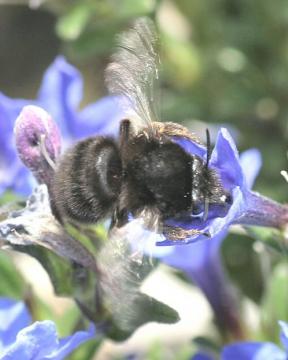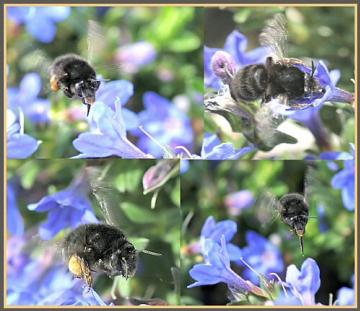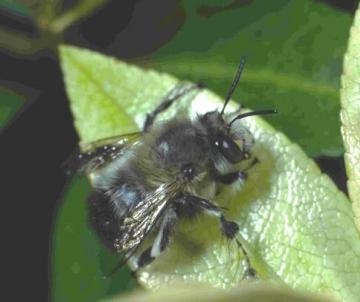Spring Flower Bee
I am very grateful to Brian Wadie for allowing the use of his excellent images of female Anthophora plumipes, and who was helped in the identification process by Paul Rules and directed to this website.
Anthophora plumipes females, both © Brian Wadie

 The Spring (Hairy-footed) Flower Bee (Anthophora plumipes) is a widespread insect that is likely to be seen in many gardens in spring and early summer.
The Spring (Hairy-footed) Flower Bee (Anthophora plumipes) is a widespread insect that is likely to be seen in many gardens in spring and early summer.It is probably well distributed in the county; especially in gardens, but is very under-recorded. It starts to appear with warm weather in March and is rarely seen after early June. It prefers sunny warm days, when its hovering and darting flight is very distinctive. It may nest in gardens, especially where there are undisturbed banks in sunny situations.
Identification is relatively straightforward as long as one does not mistake the females for a small black bumblebee. The Dark-edged bee fly also has a similar darting hovering flight, but is rather smaller and, like other flies, has only one pair of wings rather than the two pairs of bees and other Hymenoptera. The brighter male Anthophora plumipes flower bee has a fringe of very long hairs on the mid tarsus (see picture) and has a yellow face, but of course both these features may be difficult or impossible to see when the bee is in active flight.
Another bee to look out for is the Cuckoo bee Melecta albifrons, especially if you have a nesting aggregation of Anthophora plumipes. Melecta is a distinctive spring bee, about the same size as Anthophora, with the head and body entirely black except for a pair of lateral patches of white appressed hairs on most of the gastral tergites (top surface of the abdomen) and on the legs. However, in some individuals, these patches are darker, so that these are not so obvious. It is a cleptoparasite or cuckoo bee of Anthophora - this means that the bee (female) goes into an Anthophora burrow and lays its egg with the pollen food supply gathered by Anthophora. When the Melecta egg hatches the larva feeds up on the food supply intended for the Anthophora larva, pupates and emerges next year instead of the host. It is found throughout much of southern England, with an apparent bias towards the south-east. There is at least one old record for south Wales. Any records of the host Anthophora bee or the cleptoparasite Melecta bee would be very welcome.
I would welcome any observations of any of these species during the coming spring, and any records from outside Essex will be submitted to the national recording scheme run by BWARS
To see the results of records from our survey only click this link: Spring Flower Bee results



















